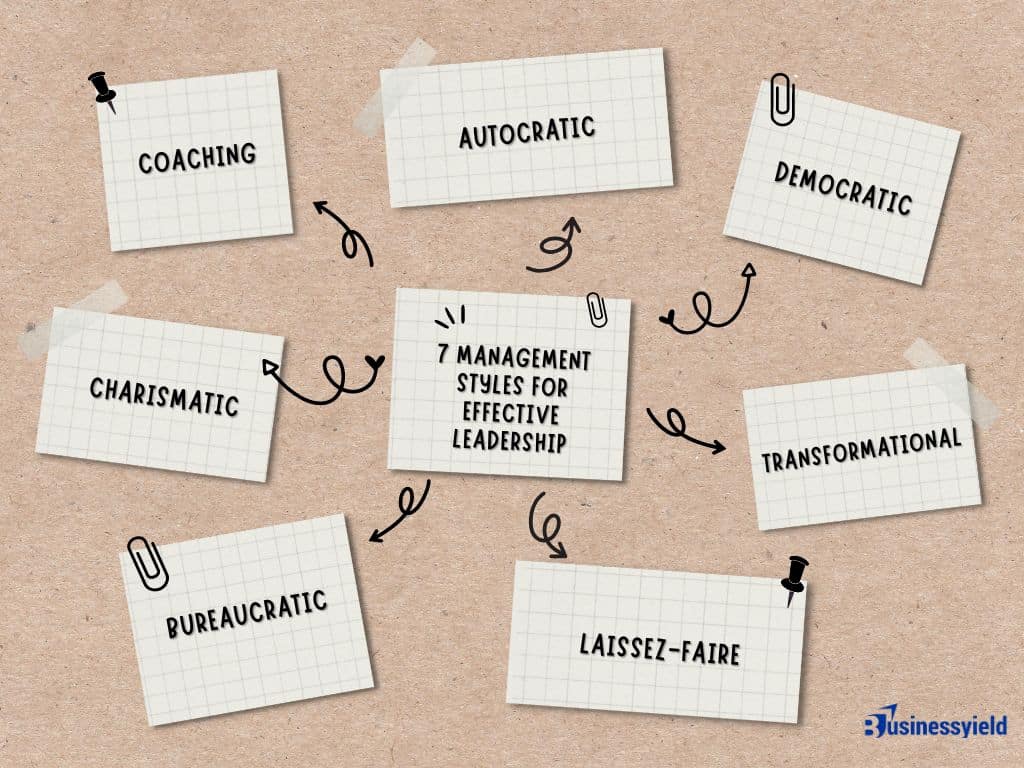Management styles are one of the most important factors when it comes to team management, which makes finding the right style absolutely essential. This is because, among other things, the right style transforms your management practice into a smoother and more effective process.
Finding the right management style will depend on your specific goals, your organization and the people involved. Each style has its own benefits and drawbacks—you won’t find a one-size-fits-all style that will suit every situation. Instead, you need to identify your character traits, your temperament, the types of employees you have and your business needs to choose the right approach.
But with so many management styles, how do you select the right one? Read on to find out.
Key takeaways
Leading an effective team requires finding the management styles that work best for you and your team.
Once you find a management style that works best, managing your team can become a much smoother and effective process.
What is a management style?
A management style is a way a manager works to reach their goals for the company. Your management style comprises how you make decisions, oversee team members, and plan and delegate tasks. Your management style might inform others how you organize work, make decisions, plan and use authority.
You might use different management styles throughout your career rather than sticking with just one. This is because effective managers use different management styles to support their needs and goals at any given time. When deciding which management style to use, they might consider some of the following factors:
- The volume of work to complete and how quickly it must be done
- Their industry and company culture
- Their personality and management qualities
- Their team and company goals
- The attitudes and personalities of the people they’re managing
7 management styles for effective leadership
There are several different management styles, from the autocratic to the transformational leadership style. When implemented correctly, all of them can be effective management styles, depending on the team and company culture.

Review these management styles to see how the above characteristics fit into each and understand how your style or someone else’s fits with the needs of a team and company.
1. Autocratic
Authoritative managers follow a top-down autocratic management style. If you go the authoritative route, then if you set expectations and your team doesn’t follow them, they could face discipline or other consequences. After you explain a process, you’ll expect your staff to perform it the same way every time without questioning it.
You’ll also watch your team closely to ensure that everything is moving along properly.
- You’ll closely track your team members to ensure they’re doing their work correctly.
- There will be consequences if a team member doesn’t hit their performance marks.
- Team members should not question your judgment.
An autocratic manager is likely to take complete control of projects and teams, making decisions without input from others. They’re more likely to give directions than to inspire team members toward solutions, and they might be more focused on details than the big-picture vision.
They aren’t likely to elicit feedback, especially from subordinates, and the feedback they give might be more critical and punitive than constructive.
When autocratic leadership works best
In most cases, autocratic management isn’t productive for a team, because it takes a top-down approach that leaves employees feeling disempowered and on edge. However, autocratic leadership can be useful temporarily when a business faces a crisis.
Autocratic leaders are skilled at making decisions fast and moving forward, which is incredibly valuable when you don’t have time to seek input and weigh options.
2. Democratic
A democratic management style is basically the opposite of an authoritative approach. This participative management style encourages your team to be a part of the process and give feedback on how things should be done.
As a democratic manager, you believe the best way that your team works is in a collaborative, conversational environment. That said, you also give yourself the final say on all decisions.
- The democratic management style encourages team members to share their ideas.
- You’ll create a collaborative environment that thrives on communication.
- You’ll still have the final say in the decision-making process.
A democratic manager is likely to solicit and implement feedback and input from members of their team, company leadership, and other project stakeholders before making final decisions. They might even designate decision-makers other than themselves for various projects to ensure variety and diversity of opinion.
Democratic leaders are not prone to snap decisions; instead, they foster an environment of consideration and debate to give everyone a voice in every step of a project.
When democratic leadership works best
Democratic leadership has a place on most teams because it ensures team members have their voices heard and have a stake in the work they do every day. Opening decisions up to multiple voices also ensure projects and goals are seen from diverse perspectives, deepening a company or team’s ability to innovate, adapt, and serve a broader customer base.
However, true democracy is a slow way to make decisions, and it could result in regular stalemates that keep projects from moving forward. Democratic leadership is best for the early stages of a project, so all stakeholders can have a say in the vision and direction.
It’s best to designate decision-makers for the minutiae of projects to ensure efficiency and progress.
3. Transformational
A transformational manager’s main focuses are innovation and employee development. You’ll challenge and gently push your team members daily to help them grow. You’ll constantly motivate your team and encourage them to start new projects – even ones that may feel are out of their wheelhouse.
- Transformational management prioritizes long-term employee growth.
- You’ll encourage your team to push their boundaries and crush their goals.
- You’ll expect your team to take on challenging tasks daily.
A transformational manager might see inspiring, motivating, and developing team members as their highest managerial priority. They thrive in constant change and rapid growth and get bored with stability and stagnation. They’re big thinkers, always pushing the vision of the company forward (regardless of their role), and they encourage team members to do the same.
These managers question the status quo and provide as much feedback to their bosses as to their subordinates.
When transformational leadership works best
Transformational management is important in rapidly growing companies, such as startups, and those within fast-changing industries. Managers need to be skilled at steering their teams through change and developing team members according to a company’s changing needs.
However, too much focus on growth and change can be detrimental to day-to-day success. Transformational leaders need to balance setting clear expectations and stable milestones to keep employees from feeling like they can never cross the finish line.
4. Laissez-faire
The laissez-faire management style allows your team members to make their own decisions about projects, but they’ll always have you in their corner for backup. You’ll be there to offer guidance, but you’ll rarely tell anyone what they should or shouldn’t do.
Think of this type of leadership style as a helping hand. You’ll give your team freedom and remain minimally involved in their projects unless they ask you for guidance.
- Laissez-faire managers give their teams more free reign when it comes to making decisions.
- You’ll be there to guide your team when they ask for it, but you’ll rarely tell them what to do.
- You won’t be heavily involved in projects.
A laissez-faire leader is likely to spend their day focused on their own work without much attention to what team members are doing. They don’t seek or offer feedback, and they don’t offer direction unless a team member asks for it. They don’t make or guide decisions for the team or projects; instead, they let individual team members make decisions as they see fit.
When laissez-faire leadership works best
Laissez-faire leadership can cause problems for many teams. Team members might feel rudderless and without support, and projects might lack cohesion because of a lack of direction or communication. However, some workers might thrive under the lack of oversight, which could help them discover their own leadership skills and leave them room to innovate.
As an overall management style, laissez-faire leadership should be reserved for high-level teams of highly skilled and experienced employees, such as C-suite and other executives. However, you could temporarily employ this style at select points throughout a project. Ease up on oversight and feedback when you want team members to strengthen decision-making skills, cope with challenges on their own, and expand creativity and innovation.
5. Bureaucratic
A bureaucratic management style relies on rules, policies and standard operating procedures, rather than a leader’s personality, interests or charisma. Team members are evaluated on standard criteria, projects are planned according to procedure and goals are meticulously measured and reported.
A bureaucratic manager is likely to document everything—processes, goals, evaluations, communications, you name it. They’re inflexible to varying employee needs and work styles because they evaluate everyone according to the same standards and communicate with everyone according to protocol.
Bureaucratic leaders make decisions through established practices, soliciting input only through approved channels and evaluating options according to predetermined criteria.
When bureaucratic leadership works best
Bureaucratic leadership is common in large organizations, where a company has to accommodate thousands of employees and projects and avoid the appearance of favoritism or bias. It can be particularly important in government organizations, where work is subject to public scrutiny. Within a team, bureaucratic management can help keep team members on the same page and streamline communication.
However, bureaucracy is only effective at facilitating equity if its goals and procedures are designed equitably. Bureaucratic leadership can cause a manager to overlook an employee’s unique circumstances and needs and inadvertently foster a work environment that favors certain types of employees—especially those who think and work like the manager.
6. Coaching
In a coaching management style, your team really is a team – it’s basically a sports metaphor. You want to lead your team to victory and perfect their skills so everyone can reach their full potential. You’ll focus so strongly on long-term growth that short-term mistakes are inevitable and okay.
- A coaching management style focuses on learning and problem-solving.
- You’ll prioritize long-term growth over correcting short-term mistakes.
- Professional development is the foundation of the coaching management style.
A coach-manager might share traits with a servant leader because they put employees’ needs and strengths at the forefront. However, they’re more in tune with how employees’ strengths, needs and skills can serve the goals of the business, and they use business objectives to help employees recognize their strengths and hone their skills.
They provide regular feedback, guidance, advice and resources to help employees succeed in their tasks for the company. They also help them develop professional skills that can help them beyond the company.
Coaching leaders involve employees in decision-making while offering clear guidance on the purpose and criteria for making a decision as well as how an employee’s stance fits in with the overall vision.
When coaching leadership works best
Coaching leadership is the best fit for managers who are in a position to help employees develop professionally. It suits managers in people-focused roles, such as learning and development, rather than in project-focused or business development roles. Mid-level managers who oversee green employees can use a coaching style to help employees develop within the projects their team is tasked with.
7. Charismatic
A charismatic management style relies on a leader’s personality and energy to inspire, engage, and motivate employees. They are in tune with and in charge of how their energy affects the people around them. They tend to have contagious personalities, make friends easily, and effortlessly command attention when they enter a room.
Charismatic managers know how to relay information and speak with each team member based on that person’s communication style and mood, and they’re known to perk up anyone in a bad mood. They can deliver critical feedback in a tone that leaves employees feeling motivated.
When charismatic leadership works best
Charismatic leaders tend to rise to the top in traditional businesses because they naturally exhibit traits our culture favors, such as extroversion, congeniality, and positivity. Managers who aren’t naturally charismatic might burn out trying to mimic these traits, though.
Charisma can be an asset when it’s your job to inspire employees and set a broad vision, but pull back on it when you need to deliver difficult news or relay tough criticism to avoid imbuing the workplace with toxic positivity.
How to adopt a new management style
Adopting or incorporating new management styles requires not only changing your behaviors and protocols but also evaluating your values, beliefs, attitude and personality type.
If you identify your predominant management style and realize some of its characteristics aren’t the right fit for your role within your organization or for the people on your team, you should consider changing it.
Below is a checklist of steps for you to adapt and incorporate characteristics of a more fitting management style:
Adopting a new management style
How to identify management styles
Understanding your own or your boss’s management style can help you communicate and work more effectively as a team. Identifying a management style early on in a hiring process can also help you determine whether a role or a team is a good fit.
Also, knowing and communicating your management style to a team can help you all make adjustments to your communication and processes as needed to work together in harmony.
To discover your management style or that of folks you’re hiring, observe the characteristics that make up the way they manage:
- Interactions with coworkers, direct reports, and direct supervisors, as well as other project stakeholders
- Communication style—how do you give and receive feedback? How do you relay and understand information?
- Decision-making steps, such as whether you get input from coworkers or prefer introspection, and whether you commit to decisions quickly or take a long time to decide
- Values and beliefs about work, leadership, productivity, and relationships
- Leadership traits, including the ability to inspire, direct, be a visionary for a project, and pay attention to details
Real-life examples of different management styles
Bill Gates

Bill Gates, the CEO of Microsoft, adopted the autocratic management style in his top-down leadership approach. Gates embodied authoritative decision-making processes that enabled him to maintain control over the direction of Microsoft. However, this style of management can discourage team members from being creative and innovative because of the lack of freedom they have.
Despite its drawbacks, Gates played a vital role in Microsoft’s success, showcasing the potential benefits of this management style when implemented effectively.
Nelson Mandela

Nelson Mandela, former President of South Africa, adopted the democratic management style through his collaborative, coaching leadership approach. By giving everyone a voice, Mandela engaged in collaborative decision-making and encouraged transparency across his team.
Mandela’s democratic management style guided South Africa and left a lasting legacy of leadership that is based on trust, inclusivity, and collaboration.
Warren Buffett

Warren Buffett, the CEO of Berkshire Hathaway, adopted the laissez-faire management style with his hands-off, delegation approach to decision-making. By giving his team members autonomy, Buffett put his trust in them to carry out his vision while providing guidance and support when needed.
Buffett’s laissez-faire management style encouraged his team members to take on new roles and be accountable for their work, which contributed to the success of Berkshire Hathaway.
Recommended Articles
- Boosting Construction Employee Productivity: Effective Time Management Strategies
- PR Crisis Management in 2024: A Guide for Businesses and Corporations
- The Future of Product Lifecycle Management: Top PLM Trends Shaping 2024
- Unveiling the Strategic Advantages of Product Feed Management for Businesses
- Redefining Asset Management with Quantum AI
- THE ULTIMATE GUIDE TO MARKETING MANAGEMENT IN 2024






